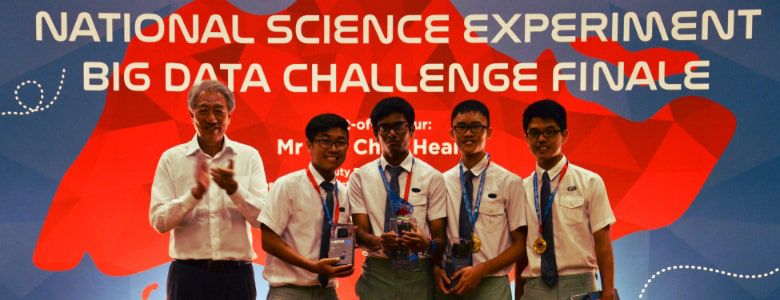Big Data reveals all

Pop quiz: What involves (a) tens of thousands of Singapore students, (b) but is not the National Day Parade, and (c) has data scientists rubbing their hands together in gleeful anticipation?
It’s the National Science Experiment (NSE), an island-wide study carried out by Singapore students to document various aspects of their daily lives.
In 2016, the experiment’s second year running, almost 50,000 students carried around a specially designed ‘laboratory on a lanyard’.
The SENSg device, developed by researchers at the Singapore University of Technology and Design (SUTD), contains sensors that measure motion, temperature, humidity, air pressure, light intensity and ambient noise.
The anonymous information is then wirelessly sent to a secure server and stored in the cloud. Students also had the opportunity to analyse the data they themselves had generated.
Subsequently, more than 50 teams from 23 schools took part in the NSE Big Data Challenge, where they worked with researchers at SUTD and A*STAR’s Institute of High Performance Computing (IHPC) to come up with innovative applications for the data.
At the Challenge finals held last month at the Science Centre Singapore, guest of honour Deputy Prime Minister Mr Teo Chee Hean said that the NSE gave students the experience of doing science outside the classroom. “We wanted to give our students the opportunity to do something on a larger scale, and with a larger social impact,” he said.
TechNews spoke to three winning teams to find out more about their projects and their experience of working with big data.
Sleeping Study
The team from the NUS High School of Mathematics and Science came out tops in the secondary school category.
“NUS High School is a really young school—we just celebrated our 10th anniversary two years ago,” said team member Mr Owen Leong. “There is really not much that is known about our school, and we wanted to find out more about the lifestyles of our students.”
One area the team focused on was students’ sleep patterns. Most students, they found, were sleeping below the recommended eight and a half hours, a trend which could pose a problem in the long run.
“Students who want to get more sleep should try to balance their schoolwork and other activities like gaming and sports,” recommended Mr Leong.
The team also looked at travel patterns to determine if students living further away from school got less sleep, but found no overall correlation. Students in far-flung locations, therefore, need not worry about a lack of sleep affecting their studies — all they needed was to stay enthusiastic about learning, said Mr Leong.
“Being able to put raw data,just text and numbers, into diagrams and figures really helped us to understand what it was trying to tell us,” said Mr Leong of his team’s experience of working with big data.
“We’ve also learnt a bit about forming hypotheses and using certain methodologies when we analyse our data.”
When Happiness happens
The SENSg device also lets students keep track of their moods by recording ‘happy moments’.
ITE College West’s Team 4, the runners-up in the tertiary category, used this data to find new ways of keeping students happy and engaged. They correlated ‘happy moments’ registered over a five-day period with data such as temperature, light, sound, location and time of day.
Students, they found, were happiest from noon to 4 pm.
“That’s when they have the opportunity to go out in the open to have fun and bond with their friends,” said team member Mr Christian Koh.
Organising activities based on this information, recommended the team, will help schools better engage students.
“This project was quite fruitful for all of us because we were able to learn new things about data analysis,” said Mr Koh. “We were also able to find new ways of making the school a much better environment, not only for us, but for everybody.”
Save the Trees
The team from Singapore Polytechnic (SP), who took first place in the tertiary category, used the data to estimate the impact their school was making on the environment.
By analysing travel patterns, they found that about 15 percent of students travelled to school in cars, the least environmentally friendly form of transport. Separately, they also found that the use of air-conditioning at SP far exceeded the national average for schools.
The school’s carbon footprint, they concluded, could be significantly reduced with some simple measures.
“If the entire SP population cut its air-conditioning usage down to the national average, as well as took public transport instead of cars to school, they would be able to save a total of 4,600 trees per year,” said team member Mr Bryston Chang.
But would his schoolmates be willing to sacrifice convenience and comfort?
“If they knew about the impact they would be able to make, which we will gladly educate them on, I think they would be challenged and inspired to help the environment,” said Mr Chang.
The team found the whole big data experience a challenging one.
“The learning curve was pretty steep because we were just thrown into this new area. But I think as a team we really pulled through and gave our best. We’re pretty shocked that we managed to get first place!”
https://www.tech.gov.sg/media/technews/big-data-reveals-all
